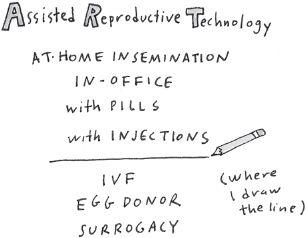One Good Egg: An Illustrated Memoir (15 page)
Read One Good Egg: An Illustrated Memoir Online
Authors: Suzy Becker
On May 28th, we met with our gynecologist. It was an 8:00 a.m. appointment. All the women in the waiting room were pregnant, shiny, and maternal without their coffee. My breasts shrank just looking at them.

The gynecologist scribbled notes while I updated her on our project: two unsuccessful at-home attempts, sperm in storage, sperm release coming up at the end of the month.
“Next month,” Lorene reminded me. I forgot there were still a few days left in May.
She looked up. “I’m going to set you up for infertility treatment with Benjamin Rankin over at Boston IVF.”
Infertility treatment? IVF?
“But I thought everything—I thought you said the labs and everything were okay.”
“They are.” She leaned forward. “You’re thirty-nine. You’ll like Benjamin; I love him. He has been doing this for years. We could start you on Clomid, but I would rather you talk to Ben first.”
“We can still try at home . . . ”
“And we can still do your IUI here. It really doesn’t change anything. We’re trying to get you pregnant, right?” Lorene and I both nodded. “Schedule your appointment with Boston IVF, and call here when your OPK’s positive at the end of—when’s your sperm available?—end of June, and you’ll come in, both of you if you want, for your insemination the next day.”
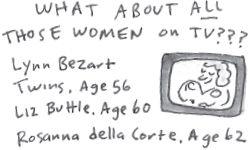
I spent the next couple of hours vetting Dr. Rankin—a very well-respected older gentleman, but not known for his comfort level working with people in “[♀]ur situati[♀]n.” A friend of mine who’d had twins through IVF canvassed her friends and gave me another name that vetted out. His first available appointment was two months away.
Maybe we won’t need it.
Lorene and I agreed to put the whole thing on dry ice until we got back from our honeymoon.
We exchanged our vows June 1st in front of the fireplace, our family, and just a few friends. There were little strawberries, champagne, and pictures afterward, and then, just married, we drove to the reception. The two of us walked through the empty restaurant to the terrace overlooking the garden, where all seventy-five guests erupted in applause and cheers. There were toasts and songs, dinner and dancing until after midnight. We have said to each other at least a hundred times since, “We got to have the wedding we always wanted.”
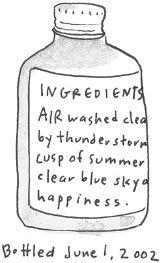

Post-honeymoon, we were back on the insemination train. Timing-wise, everything was lining up: I was due to ovulate around the 28th; Steve’s sperm would be released from quarantine June 22nd. But we ran into a problem. Only the director could authorize the release, and Tom Mecke wasn’t returning my calls.
On July 1st, I took my ovulating self to the sperm bank, armed with Steve’s HIV, hep B, and hep C test results. The Turban informed me that Steve’s lab work was incomplete, and, furthermore, per the agreement I had signed, which she flashed at me, Steve’s frozen sperm would be released only to a licensed physician.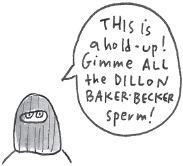 And, before I could ask, she announced that Tom Mecke was not on the premises—not behind the milky-blue doors, not watching videos in the collection room.
And, before I could ask, she announced that Tom Mecke was not on the premises—not behind the milky-blue doors, not watching videos in the collection room.
He returned my “call” nine days later. He was missing results for two tests, tests we’d discussed before Steve left in December. These tests weren’t available in Australia and Tom had agreed to exempt us.
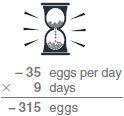
“Tom”—I was too worn down to be angry—“I have already missed one cycle. I would be willing to assume the risk; is there something I can sign? Steve has been tested six ways from Sunday—”
“Suzy, you can assume the risk for yourself, but I must protect the baby.”

Steve’s doctor found an offshore lab where she could overnight his blood, and we had the missing results a couple days before my next ovulation, which was shaping up to fall on the weekend.
Our gynecologist’s practice, however, was not set up to accommodate weekend inseminations. Come September they would be able to refer weekend IUIs to the hospital, but that was neither here nor there, the nurse explained to Lorene. My doctor would not authorize an insemination until I repeated my Day 3 labs.
Lorene had had a few hours to get used to the idea by the time she told me. “Maybe it’s all for the best; we go to Boston IVF next week.” We had been so busy not getting pregnant, the appointment had snuck up on us.

The waiting room at Boston IVF was sleek, hushed, empty, actually. The dark carpeting, glossy light-wood furniture, and warm lights confirmed that you had entered the country’s most experienced fertility center. And the fact that nobody else was in it wasn’t the least bit off-putting; it wasn’t a restaurant. Everyone was in their proper place, everything going according to plan. Within minutes we were escorted to our destination, and whoever came after us would find everything just as we had.
Dr. Penzias stood to shake our hands. He had an air of relaxed optimism that I sourced at the slight upturn of his nose and corners of his mouth. I wondered briefly why he (a bachelor somewhere between Lorene’s age and mine) had chosen the field, but in terms of intimate information, these intakes are never an even exchange. The thank-you cards and baby photos on the hallway bulletin board were all I needed.
Within twenty minutes, we had a plan: three in-office inseminations, and if they (
not we
) were unsuccessful, Dr. Penzias would argue for a diagnosis of infertility (three short of the six inseminations required by most insurance companies) on the basis of a blocked right tube and my estrogen levels, which were good for my age, but my age, face it, was in the toilet. Then we would try hormones—follicle-stimulating hormone injections—and if we hadn’t achieved pregnancy after three cycles with hormones, we agreed to discuss in vitro fertilization. It would have been rude not to agree to discuss IVF; it was Dr. Penzias’s specially, after all. The last point of the plan: We would have Steve’s sperm transferred to the storage facility at Boston IVF ASAP.
